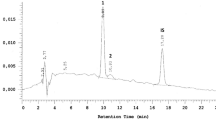Abstract
People in vast areas of the tropics suffer from vitamin A deficiency, resulting in progressive eye damage and eventually leading to blindness. Improving the content of vitamin A precursors in staple crops could alleviate or solve such a problem. The objective of this work was to study the range of variability for carotene content in a sub-set of the global cassava germplasm collection, and to determine the inheritance of carotenes, as well as their stability in response to different processing methodologies. Genotypes with more than 2 mg carotenes/100 g of fresh roots have been selected as parental material for population development. Although root colour is highly correlated with carotene content, a quantitative evaluation of genotypes selected by colour is required in order to increase the efficiency of selection. Relatively few major genes are involved in the determination of carotene accumulation in cassava roots. Stability of carotenes in response to different processing methods is genotypically dependant, representing a trait to be evaluated after selecting for high carotene concentration in fresh roots. The results from this work have provided the basis for defining future strategies for the improvement of the nutritional quality of cassava.
Similar content being viewed by others
References
Bartley, G.E., P.A. Scolnik & G. Guliano, 1994. Molecular biology of carotenoid biosynthesis in plants. Ann. Rev. Plant Physiol. Plant Mol Biol 45: 287–301.
Bokanga, M., 1994. Processing of cassava leaves for human consumption. Acta Horticulturae 375: 203–207.
Cock, J.H., 1985. Cassava: New Potential for a Neglected Crop. pp. 191. Westview Press, Boulder, Co.
Dufour, D.L., 1993. The bitter is sweet: A case study of bitter cassava (Manihot esculenta) use in Amazonia. In: C.M. Hladik, A. Hladik, O.F. Linares, H. Pagezy, A. Semple & M. Handley. (Eds.), Tropical Forests, People and Food: Biocultural Interactions and Applications to Development, pp. 575–588. UNESCO/Panthenon, Paris.
El-Sharkawy, M.A., 1993. Drought-tolerant cassava for Africa, Asia, and Latin America. BioScience 43: 441–451.
F.A.O., 1991. Necesidades de vitamina A, hierro, folato y vitamina B12. Estudios FAO Alimentación y Nutrición, No. 23. F.A.O., Roma, Italia.
Hershey, C.H., 1987. Cassava germplasm resources. In: Hershey, C.H. (Ed.), Cassava Breeding: A Multidisciplinary Review, pp. 1–24. CIAT, Cali, Colombia.
Hershey, C.H. & Ocampo, C., 1989. Description of new genetic markers in cassava. Cassava Newsletter 13: 1–5.
Howeler, R.H. & L.F. Cadavid., 1983. Accumulation and distribution of dry matter and nutrients during a 12-month growth cycle of cassava. Field Crops Res 7: 123–139.
Jos, J.S., Nair, S.G., Moorthy, S.N. & Nair, R.B., 1990. Carotene enhancement in cassava. J Root Crops 16: 5–11.
Mc Dowell, I. & Oduro, K.A., 1981. Investigation of the beta-carotene content of yellow varieties of cassava. Journal of Plant Foods 5: 169–171.
Moorthy, S.N., Jos, J.S., Nair, R.B. & Sreekumari, M.T., 1990. Variability of B-carotene content in cassava germplasm. Food Chemistry 36: 233–236.
Ortega-Flores, C.I., 1991. Carotenóides com atividade próvitamínica A e teores de cianeto em diferentes cultivares de mandioca no Estado de Sao Paulo. (Carotenes with pro-vitamin A activity and levels of cyanide in different cultivars from the State of Sao Paulo). M.S. Thesis. Universidade de Sao Paulo. Sao Paulo, Brazil. 77 p.
Safo-Katanga, O., Aboagye, P., Amartey, S.A, & Olaham, J.H., 1984. Studies on the content of yellow-pigmented cassava. In: Terry, E.R. (Eds.), Tropical Root Crops Production and Uses in Africa, pp. 103–104. IDRC, Ottawa, Canada.
Schrimpton, R., 1989. Vitamin A deficiency in Brazil, perspectives for food production oriented strategies. Ecol Food Nutr 23: 261–271.
Spungeon, S.L. & Porter, J.W., 1980. Carotenoids. In: Stumpf, P. K. and Conn E.E. (Eds.), The Biochemistry of Plants. Lipids: Structure and Function, pp. 419–483. Academic Press, New York.
W.H.O., 1995. Global prevalence of vitamin A deficiency. MDIS Working Paper # 2. W.H.O., Geneva, Switzerland.
Author information
Authors and Affiliations
Rights and permissions
About this article
Cite this article
Iglesias, C., Mayer, J., Chavez, L. et al. Genetic potential and stability of carotene content in cassava roots. Euphytica 94, 367–373 (1997). https://doi.org/10.1023/A:1002962108315
Issue Date:
DOI: https://doi.org/10.1023/A:1002962108315




